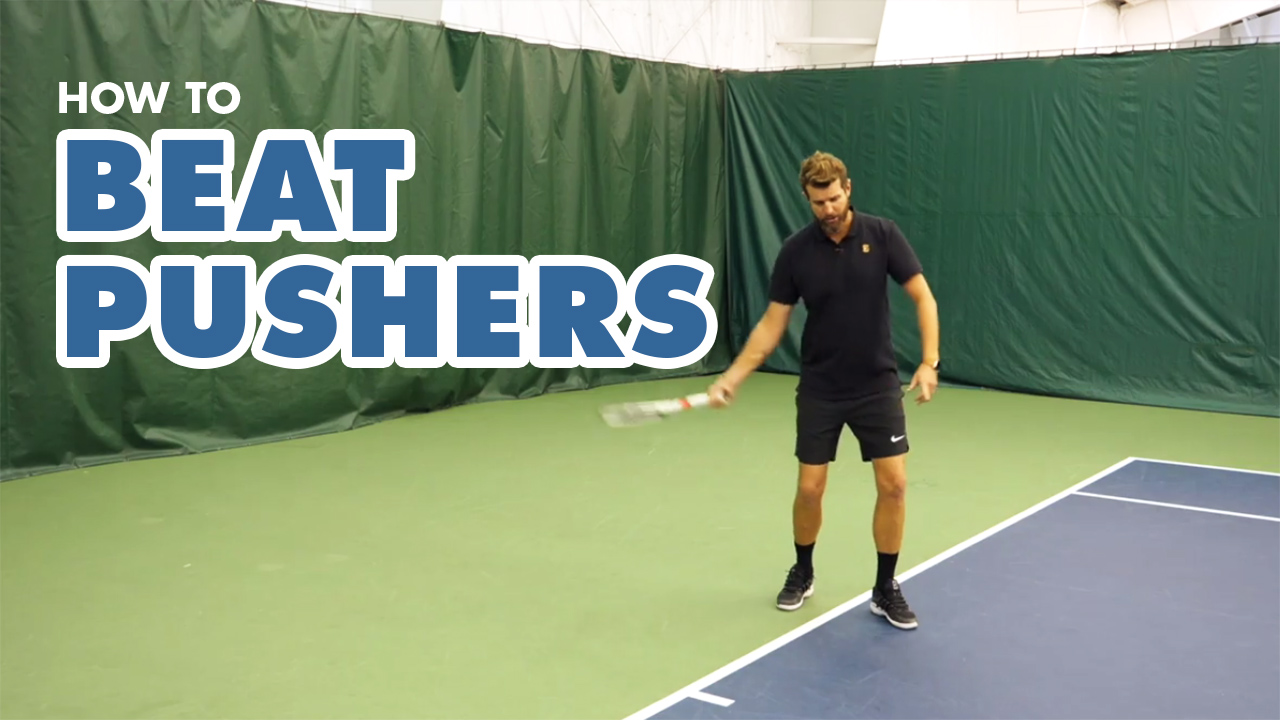Today we show you how to beat the dreaded pusher. This video is for all skill levels.
Click here to become a PYC member and get your custom video coaching: www.playyourcourt.com/tennis-community/
Here’s a transcription below for those who like to read ????:
– [Nate] Hey guys, Nate and Scott from PlayYourCourt.com, and today we are going to show you how to beat the dreaded pusher. Like my good buddy, Scott, here.
– [Scott] So, today we’re talking about everybody’s favorite subject, the dreaded pusher. And really, no matter what skill level you are, you’re going to run into this type of player at some point. So, let’s talk about it. First, I want to define a pusher. We’re all so scared of this players, but when you actually look at what they’re doing, they’re not so scary. A pusher is somebody who does no damage, they’re not hitting a lot of winners, they’re just putting the ball back in the court, and they’re letting you beat yourself. So, don’t be scared, this is a good thing. These players are just gonna get the ball back in the court and they’re gonna give you plenty of opportunities to set the point up and beat them if you’re just patient. So, that’s what I want you to focus on. When you’re playing a pusher, be patient. Wait for the right balls to attack. So, you might be asking well what are the right balls to attack? And there’s some obvious examples, a ball that’s hit short in the court and brings you in, of course, you’re going to attack. But some other opportunities to look out for when you’re playing a pusher, and you’re trying to set the point up, is to attack when balls are in the middle of the court, or when you’re balanced. You see a lot of players, they get frustrated, the pusher’s moving the ball around, and they’re out of position, they’re just over it, and they just go for way too much when they’re out of position or off balance. And this is really the time you’re most likely to make a mistake. So, what I want you to think about wait for the right opportunities, a ball that’s short, or a ball that’s in the middle third of the court where you can get your balance, transfer your weight, maybe even step into the ball to add some more power, and do some damage.
– [Nate] All right, so you might be wondering, what if I’m just not getting the short ball? What if the ball isn’t mid-court and I can’t move forward to attack the pusher? One of the issues that we run into is that oftentimes, when we’re playing a pusher, we play the point laterally behind the baseline. Moving to my right for the forehand, and moving to my left for the backhand. Part of the problem with this is that the pusher is relying upon you making mistakes. And often, they’re gonna prey on your weaker side. For most of us that happens to be our backhand. A simple strategy that’ll help diffuse this situation is to use our inside out, inside in forehand. And what we are gonna do is we’re gonna split the court 60/40. So, where this used to be my backhand, I’m now gonna make these forehands. So, what is the advantage of the inside out, inside in forehand? The first is the angle in which you can direct the ball. We can find a shorter angle out to their backhand, moving them forward, often times the pusher does not anticipate, nor like, being pulled forward. We can also spread the angle to the inside in. To clarify, the inside out is when I’m working on the inside of the ball working away from my body hitting to Arrati’s backhand. The inside in working to the left, and I’m striking the ball on the outside, working down the line. All right, this will also allow us to get a little bit more forward into the court, where I can also anticipate another short ball. This takes us to our second opportunity here. We’re looking for a swing volley, or a transition volley. All right, so, you might be thinking what in the world is a swing volley? A swing volley is your normal forehand, whether it be your semi-western or your eastern forehand. But as this ball is lofted up, I’m going to take this ball with my forehand, and I’m gonna swing under the ball, and I’m gonna work my way forward up to the net. If the ball doesn’t have much loft, I’m gonna work to a transition volley where I will then play deep into the court, and anticipate the lob for an overhead or I’ll close the net for a put-away volley. One of the key ingredients of a pusher, one of their biggest weapons is something called the reset button. And this reset button is exactly what it sounds like. When you get them in trouble, they throw up a high ball where you typically will back up on and the point resets. Here with this transition volley, or this swing volley, we don’t give up ground, and we proceed forward. The next strategy we’re gonna implement, if all else fails, taking the ball on the inside out, taking the ball on the error. If these strategies still are not working, we have one other thing that we can do. And this is to bring the pusher into the net. The vast majority of the time pushers are not gonna to be comfortable with the net. So, the main thing that we need to do is by using under spin and pulling them forward is not try to hit winners on the drop shot. Also, with a lot of my students, the mistake is they try to make the drop shot too good, and they proceed to make additional errors playing into the hands of the pusher. So with this drop shot my only goal is to get the pusher in, and from there I will look for the passing shot, or I will look for the lob.
– [Scott] So, in summary, there are four major things you wanna think about when you’re playing a pusher. Number one is definitely patience, remember these guys and gals don’t do damage, they’re gonna give you a lot of opportunity, so just be patient, and wait for the right ball.
– [Nate] Number two is attack from the middle. Look for your inside out, inside in forehand.
– [Scott] Number three, once you’ve done some damage with this inside out, inside in forehand, is get to the net. Pushers, again, just like to get the ball back in play. When you get yourself up to the net, and put the pressure on them to pass you, they’re very uncomfortable.
– [Nate] And number four if all else fails, bring the pusher in using drop shots, not winners, but drop shots to pull them in to look for the passing shot or the lob.
– [Scott] If you can remember these four things, I think you’ll find pushers aren’t quite so scary, and you’re gonna have a lot more success in your matches against them.
– [Nate] Even at 215 pounds, pushers aren’t scary. We’ll see you guys soon.
– [Scott] So, I hope you enjoy this video, I really want you to improve your tennis game, the problem is I don’t really know anything about you, or your skill level, so what I want you to do click the button below, answer a couple of quick questions for me about your game. I’m then gonna send you custom-tailored content with things that you specifically need to be working on to improve your game. Just click the button below, answer a couple of questions, and I’ll do the rest.
Click here to get your custom video coaching: https://www.playyourcourt.com/tennis-community/

